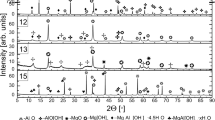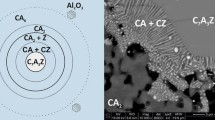Abstract
This work investigates the time-dependent hydration behavior of 1:1 molar ratio mixture of reactive α-Al2O3 nano- or micro-powder and reactive MgO in relation to the development of new hydraulic binder systems for in situ spinel refractory corundum castables. Mg–Al–CO3 hydrotalcite-like phases formed in the cementitious matrices cured in the corresponding curing condition up to 280 days of age at 50 °C were subjected to morphological, chemical and structural characterization using XRD, FT-IR, NMR, SEM and TEM techniques. The observations indicate that both the short-term cured MgO–nano-Al2O3 cementitious matrix and the long-term cured one containing micro-Al2O3 contain mainly OH–(Mg3) hydroxyl group, whereas the long-term cured MgO–nano-Al2O3 cementitious matrix is dominated by OH–(Mg2Al) hydroxyl group. The thermal stability of hydrotalcite-like compounds (Mg0.667Al0.333(OH)2(CO3)0.167(H2O)0.5, Mg6Al2CO3(OH)16·4H2O) (HTlcs) through combined DTA–TGA–EGA–MS analyses shows that HTlcs undergo dehydration first and then dehydroxylation overlapping with decarbonization processes. According to EGA–MS and FT-IR measurements, the Mg–Al cementitious matrices were progressively carbonated over curing time and then interlayer water molecules were preferably coordinated by interlayer CO3 2− ions that exist in a complex network of hydrogen bonds between octahedral layers. In the near-fully-hydrated binder paste, dehydration of crystalline water molecules occurs at 262 °C and the thermal stability of hydroxyl groups in HTlcs is OH–(Mg2Al) (422 °C) > OH–(Mg3) (337 °C) at a ramping rate of 10 °C/min. The basic information provided by the microcalorimetric measurement is such that the starting grain size significantly affects the heat flow curve. From the SEM and TEM images, the hydrates are found to be hexagonal in shape.






Similar content being viewed by others
References
Aksel’rod LM, Kaplan FS, Mel’nikova GG, Morozov SA (2000) High-quality periclase raw materials for the production of advanced refractories. Refract Ind Ceram 41(5–6):176–182. doi:10.1007/BF02693818
Kononov VA, Sturman VK (1997) Current types of imported high-alumina raw materials for refractory production. Refract Ind Ceram 38(1–2):30–33. doi:10.1007/BF02768232
Routschka G, Wuthnow H (eds) (2012) Handbook of refractory materials: design-properties-testings. Vulkan, Essen
Braulio MAL, Bittencourt LRM, Pandolfelli VC (2008) Magnesia grain size effect on in situ spinel refractory castables. J Eur Ceram Soc 28(15):2845–2852. doi:10.1016/j.jeurceramsoc.2008.05.014
Nouri-Khezrabad M, Braulio MAL, Pandolfelli VC, Golestani-Fard F, Rezaie HR (2013) Nano-bonded refractory castables. Ceram Int 39(4):3479–3497. doi:10.1016/j.ceramint.2012.11.028
Kumar V, Kumar Singh V, Srivastava A, Hemanth Kumar P (2015) Mechanochemically synthesized high alumina cement and their implementation as low cement castables with some micro-fine additives. J Asian Ceram Soc 3(1):92–102. doi:10.1016/j.jascer.2014.11.004
Berrin Gürel S, Altun A (2009) Reactive alumina production for the refractory industry. Powder Technol 196:115–121. doi:10.1016/j.powtec.2009.07.007
Maitra S, Das S (2006) Effect of TiO2 on the properties of ultralow-cement alumina-spinel castables. Refract Ind Ceram 47(1):63–67. doi:10.1007/s11148-006-0056-3
Tang X, Guo L, Chen C, Liu Q, Li T, Zhu Y (2014) The analysis of magnesium oxide hydration in three-phase reaction system. J Solid State Chem 213:32–37. doi:10.1016/j.jssc.2014.01.036
Ma W, Brown PW (1999) Mechanisms of reaction of hydratable aluminas. J Am Ceram Soc 82(2):453–456. doi:10.1111/j.1551-2916.1999.tb20085.x
Ye G, Troczyński T (2005) Effect of magnesia on strength of hydratable alumina-bonded castable refractories. J Mater Sci 40:3921–3926. doi:10.1007/s10853-005-0759-8
Cardoso FA, Innocentini MDM, Miranda MFS, Valenzuela FAO, Pandolfelli VC (2004) Drying behavior of hydratable alumina-bonded refractory castables. J Eur Ceram Soc 24(5):797–802. doi:10.1016/S0955-2219(03)00326-1
Innocentini MDM, Pardo ARF, Pandolfelli VC, Menegazzo BA, Bittencourt LRM, Rettore RP (2002) Permeability of high-alumina refractory castables based on various hydraulic binders. J Am Ceram Soc 85(6):1517–1521. doi:10.1111/j.1151-2916.2002.tb00306.x
Ghanbari Ahari K, Sharp JH, Lee WE (2002) Hydration of refractory oxides in castable bond systems—I: alumina, magnesia, and alumina-magnesia mixtures. J Eur Ceram Soc 22(4):495–503. doi:10.1016/S0955-2219(01)00299-0
GhanbariAhari K, Sharp JH, Lee WE (2003) Hydration of refractory oxides in castable bond systems—II: alumina–silica and magnesia–silica mixtures. J Eur Ceram Soc 23(16):3071–3077. doi:10.1016/S0955-2219(03)00115-8
Ye G, Troczyński T (2006) Hydration of hydratable alumina in the presence of various forms of MgO. Ceram Int 32(3):257–262. doi:10.1016/j.ceramint.2005.02.013
Zou N, Plank J (2012) Intercalation of papain enzyme into hydrotalcite type layered double hydroxide. J Phys Chem Solids 73:1127–1130. doi:10.1016/j.jpcs.2012.04.016
Roy DM, Roy R, Osborn EF (1953) The system MgO–Al2O3–H2O and influence of carbonate and nitrate ions on the phase equilibria. J Am Sci 251:337–361
Mascolo G, Marino O (1980) A new synthesis and characterization of magnesium-aluminium hydroxides. Miner Mag 43:619–621. doi:10.1180/minmag.1980.043.329.09
Towle SN, Bargar JR, Brown GE, Parks GA Jr (1997) Surface precipitation of Co(II)(aq) on Al2O3. J Colloid Interface Sci 187:62–82. doi:10.1006/jcis.1996.4539
Zhang X, Li S (2013) Mechanochemical approach for synthesis of layered double hydroxides. Appl Surf Sci 274:158–163. doi:10.1016/j.apsusc.2013.03.003
Chubar N, Gerda V, Megantari O, Mičušík M, Omastova M, Heister K, Man P, Fraissard J (2013) Applications versus properties of Mg–Al layered double hydroxides provided by their syntheses methods: alkoxide and alkoxide-free sol–gel syntheses and hydrothermal precipitation. Chem Eng J 234:284–299. doi:10.1016/j.cej.2013.08.097
Wang J, Wei Y, Yu J (2013) Influences of polyhydric alcohol co-solvents on the hydration and thermal stability of MgAl-LDH obtained via hydrothermal synthesis. Appl Clay Sci 72:37–43. doi:10.1016/j.clay.2013.01.006
Lin YJ, Li DQ, Evans DG, Duan X (2005) Modulating effect of Mg–Al–CO3 layered double hydroxides on the thermal stability of PVC resin. Polym Degrad Stab 88:286–293. doi:10.1016/j.polymdegradstab.2004.11.007
Wang L, Xu X, Evans DG, Duan X, Li D (2010) Synthesis and selective IR absorption properties of iminodiacetic-acid intercalated MgAl-layered double hydroxide. J Solid State Chem 183:1114–1119. doi:10.1016/j.jssc.2010.03.022
Mora M, López MI, Jiménez-Sanchidrián C, Ruiz JR (2013) Near- and mid-infrared spectroscopy of layered double hydroxides containing various di- and tri-valent metals. J Porous Mater 20:351–357. doi:10.1007/s10934-012-9604-z
Mora M, López MI, Jiménez-Sanchidrián C, Ruiz JR (2011) Study of organo-hybrid layered double hydroxides by medium and near infrared spectroscopy. Spectrochim Acta A 78:989–995. doi:10.1016/j.saa.2010.12.013
ICDD and ICSD PDF-2 database products
Cavani F, Trifiro F, Vaccari A (1991) Hydrotalcite-type anionic clays: preparation, properties and applications. Catal Today 11:173–301. doi:10.1016/0920-5861(91)80068-K
Cantrell DG, Gillie LJ, Lee AF, Wilson K (2005) Structure-reactivity correlations in MgAl hydrotalcite catalysts for biodiesel synthesis. Appl Catal A Gen 287:183–190. doi:10.1016/j.apcata.2005.03.027
Teng GY, Gao LJ, Xiao GM, Liu H, Lv JH (2010) Biodiesel preparation from Jatropha curcas oil catalyzed by hydrotalcite loaded with K2CO3. Biotechnol Appl Bioc 162:1725–1736. doi:10.1007/s12010-010-8953-9
Hájek M, Kutálek P, Smoláková L, Troppová I, Čapek L, Kubička D, Kocík J, Nguyen Thanh D (2015) Transesterification of rapeseed oil by Mg–Al mixed oxides with various Mg/Al molar ratio. Chem Eng J 263:160–167. doi:10.1016/j.cej.2014.11.006
Shi L, Li D, Li S, Wang J, Evans DG, Duan X (2005) Structure, flame retarding and smoke suppressing properties of Zn–Mg–Al–CO3 layered double hydroxides. Chin Sci Bull 50(11):1101–1104. doi:10.1007/BF02898472
Klug HP, Alexander LE (1974) X-ray diffraction for polycrystalline and amorphous materials, 2nd edn. Wiley, New York
Zhang J, Su H, Zhou J, Qian G, Xu Z, Xi Y, Xu Y, Theiss FL, Frost R (2013) Mid- and near-infrared spectroscopic investigation of homogeneous cation distribution in Mg x ZnyAl(x+y)/2-layered double hydroxide (LDH). J Colloid Interface Sci 411:240–246. doi:10.1016/j.jcis.2013.08.008
Sideris PJ, Nielsen UG, Gan Z, Grey CP (2008) Mg/Al ordering in layered double hydroxides revealed by multinuclear NMR spectroscopy. Science 321(5885):113–117. doi:10.1126/science.1157581
Kloprogge JT, Hickey L, Frost RL (2004) The effects of synthesis ph and hydrothermal treatment on the formation of zinc aluminium hydrotalcites. J Solid State Chem 177:4047–4057. doi:10.1016/j.jssc.2004.07.010
Tarte P (1967) Infra-red spectra of inorganic aluminates and characteristic vibrational frequencies of AlO4 tetrahedra and AlO6 octahedra. Spectrochim Acta A Mol Spectrosc 23(7):2127–2143. doi:10.1016/0584-8539(67)80100-4
Rajamathi M, Vishnu Kamath P (2000) Ageing behaviour of unary hydroxides in trivalent metal salt solutions: formation of layered double hydroxide (LDH)-like phases. Bull Mater Sci 23(5):355–359. doi:10.1007/BF02708384
Azuma K, Oda T, Tanaka S (2011) Vibration analysis of O-H stretching mode in Mg(OH)2, Ca(OH)2, LiOH, and NaOH by plane-wave pseudopotential DFT calculation. Comput Theor Chem 963:215–220. doi:10.1016/j.comptc.2010.10.029
Kloprogge JT, Wharton D, Hickey L, Frost RL (2002) Infrared and Raman study of interlayer anions CO3 2−, NO3 −, SO4 2− and ClO4 − in Mg/Alhydrotalcite. Am Mineral 87:623–629. doi:10.2138/am-2002-5-604
Li B, Zhang Y, Zhou X, Liu Z, Liu Q, Li X (2016) Different dye removal mechanisms between monodispersed and uniform hexagonal thin plate-like MgAl–CO 23 –LDH and its calcined product in efficient removal of Congo red from water. J Alloys Compd 673:265–271. doi:10.1016/j.jallcom.2016.02.248
Valente JS, Pfeiffer H, Lima E, Prince J, Flores J (2011) Cyanoethylation of alcohols by activated Mg-Al layered double hydroxides: influence of rehydration conditions and Mg/Al molar ratio on Brönsted basicity. J Catal 279:196–204. doi:10.1016/j.jcat.2011.01.018
Wang Y, Luo S, Wang Z, Fu Y (2013) Structural and textural evolution of nanocrystalline Mg-Al layered double hydroxides during mechanical treatment. Appl Clay Sci 80–81:334–339. doi:10.1016/j.clay.2013.05.015
Zhou J, Su Y, Zhang J, Xu X, Zhao J, Qian G, Xu Y (2015) Distribution of OH bond to metal-oxide in Mg3−x Ca x Fe-layered double hydroxide (x = 0–1.5): its role in adsorption of selenate and chromate. Chem Eng J 262:383–389. doi:10.1016/j.cej.2014.10.010
Stanimirova T, Balek V (2008) Characterization of layered double hydroxide Mg–Al–CO3 prepared by re-hydration of Mg–Al mixed oxide. J Therm Anal Calorim 94(2):477–481. doi:10.1016/j.cej.2014.10.010
Zhang J, Xu YF, Qian G, Xu ZP, Chen C, Liu Q (2010) Reinvestigation of dehydration and dehydroxylation of hydrotalcite-like compounds through combined TG–DTA–MS analyses. J Phys Chem C 114(24):10768–10774. doi:10.1021/jp103115q
Funding
This study was funded by Faculty of Materials Science and Ceramics of AGH University of Science and Technology (Grant No. 11.11.160.617).
Author information
Authors and Affiliations
Corresponding author
Ethics declarations
Conflict of interest
The authors declare that they have no conflict of interest.
Rights and permissions
About this article
Cite this article
Madej, D. Size-dependent hydration mechanism and kinetics for reactive MgO and Al2O3 powders with respect to the calcia-free hydraulic binder systems designed for refractory castables. J Mater Sci 52, 7578–7590 (2017). https://doi.org/10.1007/s10853-017-0990-0
Received:
Accepted:
Published:
Issue Date:
DOI: https://doi.org/10.1007/s10853-017-0990-0




